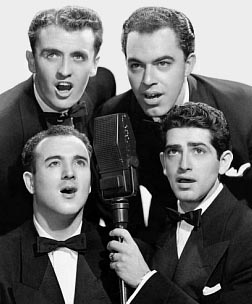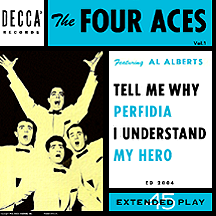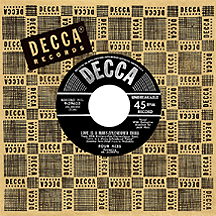THE FOUR ACES
Al Alberts, a musician from the big band era, and his group The Four Aces, formed as an instrumental combo and later made their mark performing in the harmonic tradition of early 20th century vocal quartets. By the time they made their first record in 1951, the window of opportunity for a group of this type was limited, as the R&B, country and blues of the decade was already evolving into the resultant rock and roll movement that changed the way everyone, even pop acts, approached their material; that is, if the goal was to get mainstream radio airplay and sell millions of records. The Aces stayed true to their music of preference, a diehard pop act performing standards, show tunes and movie themes (even chief rivals The Ames Brothers adapted as the decade wore on). Turns out that window was open for a little over seven years, during which time they put more than 30 songs on the charts. Eight reached the top ten of the best sellers and, surprising though it may seem (nine groups achieved the same feat during the '60s), that was more than any other group act during the 1950s.
Al (born Albert Albertini) had played piano with a couple of lesser-known big bands while still in his teens, but World War II put his career on hold. Serving a tour of the Navy, the South Philadelphia native met tenor sax player Dave Mahoney from nearby Chester, Pennsylvania and the two decided they would start their own group after the war. The combo came together in 1946 with two more Philly-area musicians, trumpeter Rosario "Sod" Vaccaro and drummer Lou Silvestri. Singing wasn't in the cards for these guys at first; besides, they probably wouldn't have been any good at it anyway!
The Four Aces name was a spur-of-the-moment decision taken from a roller rink Lou liked to frequent called the Aces. Staying close to home, they secured a steady engagement at the Old Mill, a nightclub in Concordville, just a few miles from Chester, guaranteeing seven bucks a night for each of them (chicken feed if one is to believe the rumor that the owners were running a casino on the floor above!) Management requested they throw in a few vocals to break up the instrumental numbers, hinting that it could mean their jobs if they continued playing nothing more than "background" music. Alberts figured he could pull off singing and gave it a shot. Word got around he was pretty good and the club started packing in the patrons. With all the money coming in, it seemed only fair to ask for a raise - a mere fin per man. Management refused and they left to perform at a private club. More money, less clientele. The guys actually had a lower self-image than most would under the circumstances, but continued working to improve themselves, practicing group vocals and finding they complemented each other well; Al and Dave were tenors, Marty had a decent baritone voice and Lou could hit those deep bass notes.
When songwriters George Hoven and Chester Shull started coming around with a song they wanted the Four Aces to add to their set, the group resisted. But the persistence of the writers and the dead end of the private club gig eventually helped Alberts and company overcome any initial reluctance. Further incentive came by way of those pesky Ames Brothers, a similar-styled traditional vocal quartet from Massachusetts, who had jumped into the new decade with "Rag Mop" and "Sentimental Me," two of the biggest hits of 1950. If they could make records, why not the Four Aces? The guys returned to the Old Mill to reclaim their territory (and got the raises they wanted too) and took Hoven and Shull up on their offer. The song in question had an odd title, "Sin" (also known as "(It's No) Sin"), but customers at the club liked it and began requesting the song every night. The Four Aces decided to make a record of it, but didn't really think it had hit potential. They really just wanted to be able to bill themselves as "recording artists."
Well, maybe the lack of confidence was well-founded. After recording the song at a nearby studio, they approached several New York record labels with it. No one was interested. Figuring they could sell, say, five hundred copies to customers at the club, they decided to start a label and call it Queen Victoria Records (for no particular reason other than the name had a "bigger-than-life" sound) with the help of a couple of friends who invested a thousand dollars. Alberts kicked in about five hundred bucks of his own that he was planning to use to get married; as a result, the wedding was postponed for a couple of years (which was no problem - Al and his wife Stella eventually passed the 50th anniversary mark). The label's name was shortened to Victoria, its logo so large it took up most of the space on the label. Just to see what might happen, they dropped off copies at a few local radio stations...and "Sin" started getting played. A lot.
This whole process took several months, but the payoff came in September 1951 when the record hit the national charts. An independent company, Palda Records, took over distribution of the Victoria single, also releasing it on the Flash label in some regions. As soon as the Aces started to climb the charts, cover versions by established recording acts started popping up, to the delight of the song's composers. Eddy Howard, about as old-fashioned a song stylist as existed in the '50s, hit first, just one week behind the Four Aces. By the time their original peaked in the top ten in November, Howard's "Sin" single had leapfrogged into the number one spot, and many still associate him more closely with the song. Jazz singer Savannah Churchill simultaneously took her version to the top ten and covers by The Billy Williams Quartet, The Four Knights and Sammy Kaye (with vocals by The Kaydets) appeared before year's end.

The labels that had rejected them months before were suddenly bidding on the Four Aces, with Decca Records winning out, locking them into a long-term contract while the record was still on the rise. The first single for the major label, "Tell Me Why," written by Alberts and Marty Gold, was one of those surefire number one hits with unfortunate timing; it held at number two in January and February '52 behind the year's biggest blockbuster, Johnnie Ray's "Cry." Second Decca single "Perfidia" (a hit for several artists in 1941, most notably Latin bandleader Xavier Cugat) was top ten within weeks. Palda sneaked out a pre-Decca recording on the Flash label, "Two Little Kisses," which was a minor hit. The four continued incorporating their musical instruments into the act but gradually set them aside to focus on being a full-time vocal group. Working with a choreographer, they developed their stage presence and became very good at it, using arm movements, dance steps and the like, in sync with each other at every musical accent, every line of a song; it was a visual style that audiences reacted to, female fans in particular.
While their image was very '50s, the song selections recalled an earlier time, yet the combination worked well for the group through the next few years. Credited as The Four Aces featuring Al Alberts soon after joining Decca, their hits included the Hoagy Carmichael-Frank Loesser song "Heart and Soul" (from the '30s) and Ben Ryan's "The Gang That Sang 'Heart of My Heart'" (a '20s tune) as well as the more contemporary "Stranger in Paradise" (written by Robert Wright and George Forrest for the Tony Award-winning 1953 musical Kismet), competing neck-and-neck with Tony Bennett, both versions top ten in early 1954. "Three Coins in the Fountain," Jule Styne and Sammy Cahn's Academy Award-winning title song from the popular '54 movie (though frankly, the song is much better than the film) was the Aces' biggest hit yet, outdistancing a hit rendition by Frank Sinatra. They landed in the top ten of the best seller charts for the seventh time late in the year with a cover of the Pat Ballard tune "Mister Sandman" (you know it better by The Chordettes, but the Aces version was cool enough, even after three decades, for inclusion in Robert Zemeckis's smash 1985 film Back to the Future). The standards plus showtunes plus movie themes formula was working like a charm...but wouldn't fly for much longer. Time hadn't quite run out, though; their biggest hit, that elusive chart-topper, was right around the corner.
"Love is a Many-Splendored Thing" is one of those silver screen songs that's better remembered today than the movie it was taken from. Written by Sammy Fain and Paul Francis Webster, it too won the Oscar for Best Song (the year after "Three Coins"). While not sung by the Four Aces in the film, their rendition is the definitive one, a number one hit in the fall of 1955. The group's greatest triumph was also their last major seller, though they appeared on the charts consistently for the next three years. There were more standards and an emphasis on movie themes (Loesser's "A Woman in Love" from Guys and Dolls, Dimitri Tiomkin and Webster's "Friendly Persuasion," Victor Young and Cahn's "Written on the Wind" and others), all selling respectably but not spectacularly.
After more than a year without a big hit, the Four Aces acquiesced to the current trend with the first of two ersatz attempts at rock and roll: Luther Dixon's "Bahama Mama," in the spring of 1957, trepidaciously employed a semi-rocking arrangement to minimal fanfare. A year later, "Rock and Roll Rhapsody" (written by Bob Davie and Marvin Moore) was released, but had nothing remotely to offer the teenage record-buying majority growing larger with each passing day; the lyrics, in fact, exposed the ruse: 'They played rock and roll, you danced with me, and changed the music to a rhapsody...,' suggesting R&R was so objectionable that it was preferable to imagine '...violins where none should be' in order to tolerate the modern music. It was, perhaps, a desperate eleventh hour appeal that fell on deaf ears.
Alberts broke away after that to focus on a solo career, but none of his releases were successful. Fred Diodati, also from South Philly, took his place, carrying on the group's name for concert appearances long after the other original members had departed. In 1976, Diodati's in-name-only Four Aces outfit found they had some formidable competition when the founding quartet reunited as The Original Four Aces featuring Al Alberts. Recapturing some of that early-'50s magic, Al, Dave, Sod and Lou appeared regularly together on the oldies circuit until 1987.
NOTABLE SINGLES:
- Sin - 1951
- Tell Me Why /
A Garden in the Rain - 1952 - Perfidia - 1952
- Two Little Kisses - 1952
- I'm Yours - 1952
- Should I - 1952
- Heart and Soul /
Just Squeeze Me (But Don't Tease Me) - 1952 - Stranger in Paradise /
The Gang That Sang "Heart of My Heart" - 1953 - Three Coins in the Fountain /
Wedding Bells (Are Breaking Up That Old Gang of Mine) - 1954 - It's a Woman's World - 1954
- Mister Sandman - 1954
- Melody of Love - 1955
- Heart - 1955
- Love is a Many-Splendored Thing - 1955
- A Woman in Love /
Of This I'm Sure - 1955 - If You Can Dream - 1956
- To Love Again - 1956
- Dreamer /
I Only Know I Love You - 1956 - Friendly Persuasion (Thee I Love) /
You Can't Run Away From It - 1956 - Someone to Love /
Written on the Wind - 1956 - Bahama Mama /
You're Mine - 1957 - Rock and Roll Rhapsody - 1958
- The World Outside - 1958
- No Other Arms, No Other Lips - 1959



